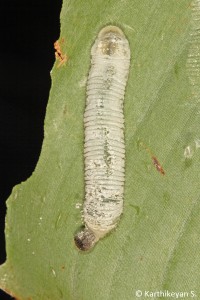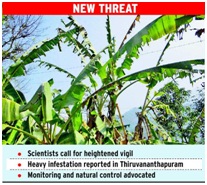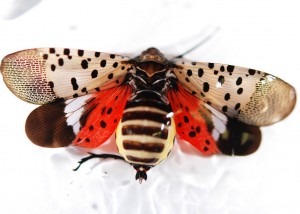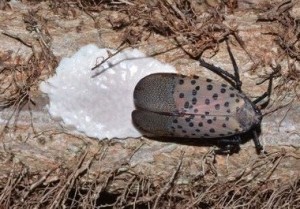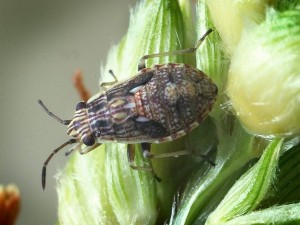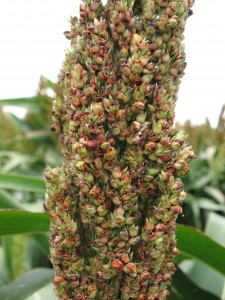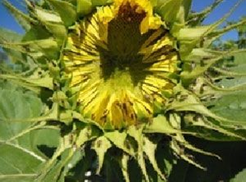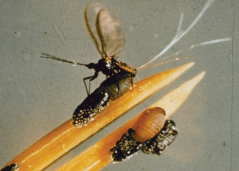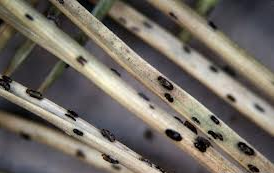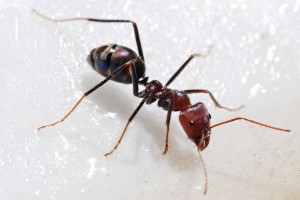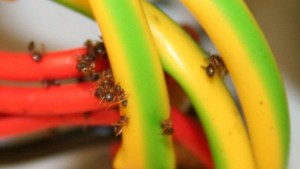 Found in a rainbow of North American plants from avocados to beans, onions, citrus trees and market flowers, thrips are tiny insects. These species that are plant feeders can scar leaf, flower or fruit surfaces with silvery speckling when they puncture and suck out the cell’s content. Conversely, heavy pest populations can severely distort flowers and damage fruit. Other thrip species function as beneficial insects by eating mites, fungal spores and pollen.
Found in a rainbow of North American plants from avocados to beans, onions, citrus trees and market flowers, thrips are tiny insects. These species that are plant feeders can scar leaf, flower or fruit surfaces with silvery speckling when they puncture and suck out the cell’s content. Conversely, heavy pest populations can severely distort flowers and damage fruit. Other thrip species function as beneficial insects by eating mites, fungal spores and pollen.
When thrips have fed on a bud, it will often fail to open; or if it does open, the flower will be deformed. Flowers upon which the thrips feed may also become streaked and/or discolored. When thrips feed on plant leaves, the leaves will dry out and appear speckled with silvery flakes. The leaves will eventually wilt and fall off.
To lay its eggs, the female thrip will make a slit in a leaf then lay 25 to 50 eggs within it. The eggs can develop into adults within three weeks, or sooner for some species. Many species of thrips also reproduce asexually. They can produce many generations in a single season.
In addition to damaging and feeding on plants, thrips are known to bite humans. They can cause both skin and respiratory irritation to people, according to the University of Michigan, particularly to workers in fields where infestations exist.
 Thrips are small insects, only about 1/20″, but they can cause a lot of damage. At maturity, they are yellowish or blackish with fringed wings. Nymphs have a similar shape but lack the wings. They are usually yellowish to white. Thrips are poor flyers. As a result, damage often occurs in one part of the plant then slowly spreads throughout it.
Thrips are small insects, only about 1/20″, but they can cause a lot of damage. At maturity, they are yellowish or blackish with fringed wings. Nymphs have a similar shape but lack the wings. They are usually yellowish to white. Thrips are poor flyers. As a result, damage often occurs in one part of the plant then slowly spreads throughout it.
 Thrips feed in buds, folded leaves, and other unexposed areas of plants. This makes them difficult to treat with an insecticide. They feed by sucking juices from the plant causing stippling, or small scars, on leaves, flowers and fruit. This results in stunting of the plant, leaf distortion and premature leaf drop. Flowers may be deformed and fail to open properly. Petals may show brown streaks and spots. Their excrement is black and shiny, which may be a clue to their presence. In addition to this physical damage, thrips also transmit tomato spotted wilt virus and impatiens necrotic spot virus, for which there is no control.
Thrips feed in buds, folded leaves, and other unexposed areas of plants. This makes them difficult to treat with an insecticide. They feed by sucking juices from the plant causing stippling, or small scars, on leaves, flowers and fruit. This results in stunting of the plant, leaf distortion and premature leaf drop. Flowers may be deformed and fail to open properly. Petals may show brown streaks and spots. Their excrement is black and shiny, which may be a clue to their presence. In addition to this physical damage, thrips also transmit tomato spotted wilt virus and impatiens necrotic spot virus, for which there is no control.
If enough thrips attack a plant, the leaves may take on a silver streaked appearance. When there is a large enough infestations of thrips, the plant can be severely damaged. Fruits will not be able to fully mature.
 In many species, thrips feed within buds and furled leaves or in other enclosed parts of the plant. Their damage is often observed before the thrips are seen. Discolored or distorted plant tissue or black specks of feces around stippled leaf surfaces are clues that thrips are or were present. However, some abiotic disorders, pathogens, and certain other invertebrates can cause damage resembling that of thrips. For example, lace bugs, plant bugs, and mites also stipple foliage, and lace bugs and certain plant bugs produce dark, watery fecal specks. Look carefully for the insects themselves to be certain that pest thrips are present and the cause of damage before taking control action.
In many species, thrips feed within buds and furled leaves or in other enclosed parts of the plant. Their damage is often observed before the thrips are seen. Discolored or distorted plant tissue or black specks of feces around stippled leaf surfaces are clues that thrips are or were present. However, some abiotic disorders, pathogens, and certain other invertebrates can cause damage resembling that of thrips. For example, lace bugs, plant bugs, and mites also stipple foliage, and lace bugs and certain plant bugs produce dark, watery fecal specks. Look carefully for the insects themselves to be certain that pest thrips are present and the cause of damage before taking control action.
Thrips are poor fliers but can readily spread long distances by floating with the wind or being transported on infested plants. New thrips introductions can pose serious threats and complicate identification. A recent introduction of Klambothrips myopori has caused serious leaf and shoot galling damage to Myoporum laetum(ngaio tree) and Myoporum ‘Pacificum’ (a groundcover) along the coast of California. This thrips was both a new introduction and an undescribed species, so that initially not even the experts knew what to call it or how it might be managed. This species is now well established and from its original detection site in San Diego has spread north along the coast to at least as far as Santa Barbara. It is expected to continue to spread to wherever Myoporum species have been planted.
Thrips prefer to feed in rapidly growing tissue. Feeding by thrips typically causes tiny scars on leaves and fruit, called stippling, and can stunt growth. Damaged leaves may become papery and distorted. Infested terminals may discolor, become rolled, and drop leaves prematurely. Petals may exhibit “color break,” which is pale or dark discoloring of petal tissue that was killed by thrips feeding before buds opened. Thrips cause silvery to brownish, scabby scarring on the avocado and citrus fruit surface, but this cosmetic damage does not harm the internal fruit quality. Feces may remain on leaves or fruit long after thrips have left. Where thrips lay eggs on grapes, dark scars surrounded by lighter “halos” may be found on the fruit. Thrips feeding on raspberries, apples, and nectarines can deform or scar developing fruit; sugar pea pods may be scarred or deformed. Citrus thrips feeding severely distorts blueberry shoot tips and foliage, reducing fruit yield.
Western flower thrips are primarily pests of herbaceous plants, but high populations occasionally damage continuously- or late-blossoming flowers on woody plants such as roses. Some plant-feeding thrips are also predaceous on other pests, such as spider mites. In young cotton seedlings in California, western flower thrips is considered beneficial because it feeds on spider mites.
Behavior, body appearance, and host plants help to distinguish among thrips species. For example, three dark spots on each forewing distinguish the adult predaceous six spotted thrips from pest thrips. Adults of western flower thrips and onion thrips, are noticeably larger than avocado and citrus thrips adults, so mature body size helps to distinguish them when they occur together on the same host plant. However, thrips can be positively identified to species only by an expert. Fortunately, most thrips are susceptible to some of the same controls, such as exclusion and pesticides.
It is more important to distinguish among thrips species in situations where integrated pest management methods are used. For example, predatory thrips or other natural enemies are highly specific to certain pests and are likely to help control only certain species of plant-feeding thrips. Certain thrips occur on many different plants but damage only a few of the plant species on which they are found, so identifying the thrips species may reveal that it is harmless in that situation and no control action is needed. For example, avocado fruit skin is scarred by avocado thrips and greenhouse thrips, but citrus thrips and western flower thrips are harmless in avocado. Citrus thrips occurs on many species of plants but damages only blueberries and citrus.
Although thrips damage to leaves is unsightly, thrips activity does not usually warrant the use of insecticide sprays. For instance, while thrips damage on citrus or avocado fruit may look unpleasant, it does not harm trees or affect the internal fruit quality. When damage is noticed on ripening fruit or distorted terminals, the thrips that caused the injury are often gone. It’s not until later when tissue grows and expands that injury caused earlier becomes apparent. While viruses vectored by thrips may cause plant loss, insecticide sprays are not recommended to prevent viruses because thrips are not killed fast enough to prevent the transfer of the virus to new plants. Prevention of thrips infestations is the only way to prevent infection by thrips-vectored viruses.
C Tech Corporation can offer a solution to overcome this problem. Our product Combirepel™ is an extremely low toxicity and extremely low hazard and eco-friendly rodent aversive. Combirepel™ is available in the form of solid masterbatches, liquid concentrate and in lacquer form. The product is compliant with RoHS, RoHS2, and REACH and is FIFRA exempted. This product acts through a series of highly developed intricate mechanism ensuring that rodents are kept away from the target application.
The fencing and tree guards can be coated withCombirepel™ to protect the trees, shrubs etc. from the damage caused by the grey squirrels. The product can also be incorporated into agricultural films, greenhouse films, plastic mulches used on a large scale in the agriculture as well as horticulture sector in order to avoid damages caused by these squirrels to fruits and vegetables. Also, the products can be directly incorporated in the polymer matrix during processing of pipes and tubing. Combirepel™ does not leach out, thus there is no soil pollution. Groundwater reserves are also not polluted. Also the non-target beneficial species like earthworms, bees etc are not affected.
The product is compliant with ROHS, ROHS2, ISO, REACH, APVMA, NEA, EU-BPR, and FIFRA exempted.
Contact us at technical.marketing@ctechcorporation.com if you’re facing problems with rodents and get best remedies to combat the pest menace.
Also, visit our websites:
http://www.ctechcorporation.com/
http://www.rodrepel.com/
http://www.termirepel.com/
http://www.combirepel.com/
Follow our Facebook pages at:
1] https://www.facebook.com/Combirepel-411710912249274/
2] https://www.facebook.com/Termirepel-104225413091251/
3] https://www.facebook.com/Rodrepel-120734974768048/
Follow us on our Twitter pages at:
1] https://twitter.com/rodrepel
2] https://twitter.com/termirepel
3] https://twitter.com/combirepel



